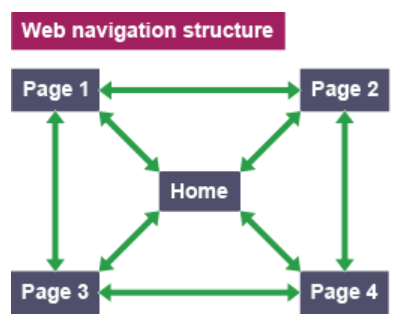Types of Website Organization Examples & How It Impacts SEO
Although website organization structure may seem like a minor detail, it plays an important role in both users’ ability to access the information they’re looking for and search engine rankings.
While there are no industry-wide standards, there are best practices that can help your website rank better and provide more value to visitors by creating clear and consistent pathways through your site’s content.
In this article, we’ll cover the different types of website organization examples, as well as how each impacts SEO and CX.
What is a Website Organization Structure, and Why Does It Matter?
A website’s structure can be defined as the intuitive projection of informational space.
In particular, this is important to the process of developing an information architecture with proper navigation.
Think of it as the way in which web pages are linked together.
This site architecture definition includes the layout of a site’s main navigation system, as well as any sub-navigations within each section.
A well-organized site helps visitors find relevant information quickly and consistently and allows search engines to crawl and index the site.
It helps to form discernible, discoverable, and predictable patterns.
As you can imagine, it affects your website in numerous ways, including search engine optimization (SEO) and user experience (UX).
If you want to take the legwork out of finding the right programmers and designers for your project, Legiit can make getting what you need on your website a lot easier.

You’re guaranteed to find someone with an impressive portfolio featured on its site.
The Ideal Site Structure Is a Pyramid
The site architecture definition is the way in which a website is organized.
The ideal type of site architecture is the pyramid, which is made up of three essential structures: the home page, the category pages, and the product pages.
The home page is the most important page on the site, as it is the first page that people will see when they visit your site.
The category pages are used to organize your products into groups, and the product pages are where people can learn more about individual products.
You should focus on creating a meaningful information hierarchy within every page, so the visitors have less to ponder when it comes to consuming information from important pages.
The Most Common Types of Website Structures
1. Hierarchical Model
In a hierarchical model, also known as a tree structure, information is organized in a series of parent-child relationships.
For example, the top-level pages or categories are considered parents, while the subcategories are considered children.

This type of website architecture is easy for users to navigate and understand, and it is the most common website organization.
Having a tangled website makes it difficult for search engines to crawl it, so this is an area where being careful matters.
A well-organized hierarchical site will have a clear site architecture definition that helps search engines understand the relationship between different pages.
2. Sequential (Linear) Model
A sequential model is a form of organization in which content organizes in a linear, chronological fashion.
In this type of organization, each piece of content builds upon the last, making it ideal for organizing all forms of content present in a specific order.

This type of organization can be great for SEO since it allows you to control the flow of information and ensure that users are seeing the most important information first.
However, it can also be limiting if your content doesn’t fit well into a linear format.
Keep in mind that not every site will be able to use this type of structure, but it is a low-maintenance option if you have fewer pages.
For example, wikiHow.com has pages designed with a sequence in mind.
3. Network Model (Web Navigation/Matrix Model)
The network model is a type of website organization where each page links to every other page on the site.
Think of it as…
A web of the main page, parent pages, and child pages that are all interlinked with each other.
This means that you can reach everything with minimal clicks.

This can be beneficial for SEO because it allows Google to easily crawl and index all the individual pages on your site.
However, if one page on your site goes down, all the other pages will react the same way.
This model is one of the oldest website structure types on the internet.
Visitors can change their minds and decide to go in another direction even if they are deep into your website.
E-commerce websites can definitively use this structure.
Create a Website Organization Structure That Helps Users
In conclusion, there are many types of website organizations, each with its own strengths and weaknesses.
You want to create a great website structure that is easy for users to understand.
The type of organization you choose should be based on your business goals and objectives.
Keep in mind that the way you organize your website can have a big impact on your search engine optimization (SEO) efforts.
Choose an organizational method that will help you achieve your desired results.
That’s how you can improve your chances of ranking higher in search engine results pages (SERPs).





